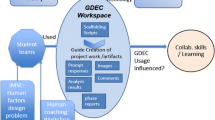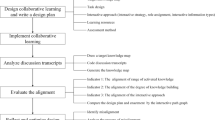Abstract
Computer-supported collaborative learning (CSCL) is widely adopted in industry learning, but it still faces challenges, including low participation, distraction, and learning inefficiency. In our study, we follow the design science research method to develop artifacts (a process and discussion platform) to address these CSCL challenges. Collaboration engineering was used as our design theory. A Discussion Platform was designed as a tool to help non-expert practitioner instruct collaborative learning process. We carried out evaluations on the two designed artifacts through 81 managers working in various industries through a mixed-method approach, including survey and qualitative interviews. We find that our designed artifacts receive high satisfaction in industry CSCL and reduce problems of low participation, distraction, and learning inefficiency. We identified several factors that contribute to the problem solving of low participation, distraction and inefficiency in industry CSCL, including usability, expression affordance, process guidance, goal clarity, flexibility affordance, thinkLet instruction, and flow experiences.



Similar content being viewed by others
References
Ackermann F (1996) Participants’ perceptions on the role of facilitators using group decision support systems. Group Decis Negot 5(1):93–112
Alavi M, Wheeler BC, Valacich JS (1995) Using IT to reengineer business education: an exploratory investigation of collaborative telelearning. MIS Q 19(3):293–312
Arnott D (2006) Cognitive biases and decision support systems development: a design science approach. Inf Syst J 16(1):55–78
Balasubramanian N, Lieberman MB (2010) Industry learning environments and the heterogeneity of firm performance. Strateg Manag J 31(4):390–412
Boekaerts M, Corno L (2005) Self-regulation in the classroom: a perspective on assessment and intervention. Appl Psychol 54(2):199–231
Briggs RO, De Vreede GJ, Nunamaker JF Jr (2003) Collaboration engineering with ThinkLets to pursue sustained success with group support systems. J Manag Inf Syst 19(4):31–64
Briggs RO, Reinig BA, de Vreede GJ (2008) The yield shift theory of satisfaction and its application to the IS/IT domain. J Assoc Inf Syst 9(5):267–293
Briggs RO, Kolfschoten GL, de Vreede GJ, Lukosch S, Albrecht CC (2013) Facilitator-in-a-box: process support applications to help practitioners realize the potential of collaboration technology. J Manag Inf Syst 29(4):159–194
Bryson N, Mobolurin A (1997) An action learning evaluation procedure for multiple criteria decision making problems. Eur J Oper Res 96(2):379–386
Chang CC, Liang C, Chou PN, Lin GY (2017) Is game-based learning better in flow experience and various types of cognitive load than non-game-based learning?: Perspective from multimedia and media richness. Comput Hum Behav 71:218–227
Cheng X, Nolan T, Macaulay L (2013) Don’t give up the community: a viewpoint of trust development in online collaboration. Inf Technol People 26(3):298–318
Cheng X, Fu S, Druckenmiller D (2016a) Trust development in globally distributed collaboration: a case of US and Chinese mixed teams. J Manag Inf Syst 33(4):978–1007
Cheng X, Li Y, Sun J, Huang J (2016b) Application of a novel collaboration engineering method for learning design: a case study. Br J Educ Technol 47(4):803–818
Davison RM, Briggs RO (2000) GSS for presentation support. Commun ACM 43(9):91–97
de Vreede GJ (2014) Two case studies of achieving repeatable team performance through collaboration engineering. MIS Q Exec 13(2):115–129
de Vreede GJ, Briggs RO (2019) A program of collaboration engineering research and practice: contributions, insights, and future directions. J Manag Inf Syst 36(1):74–119
De Vreede GJ, Briggs RO, Massey AP (2009) Collaboration engineering: foundations and opportunities: editorial to the special issue on the journal of the association of information systems. J Assoc Inf Syst 10(3):121–137
Eden C, Ackermann F (2013) Making strategy: the journey of strategic management. Sage, New Delhi
Gregor S, Hevner AR (2013) Positioning and presenting design science research for maximum impact. MIS Q 37(2):337–355
Griffith TL, Fuller MA, Northcraft GB (1998) Facilitator influence in group support systems: intended and unintended effects. Inf Syst Res 9(1):20–36
Haas MR, Criscuolo P, George G (2015) Which problems to solve? Online knowledge sharing and attention allocation in organizations. Acad Manag J 58(3):680–711
He W, Yang L (2016) Using wikis in team collaboration: a media capability perspective. Inf Manag 53(7):846–856
Hevner A, March S, Park J, Ram S (2004) Design science in information systems research. MIS Q 28(1):75–105
Huang TC, Huang YM, Yu FY (2011) Cooperative weblog learning in higher education: its facilitating effects on social interaction, time lag, and cognitive load. Educ Technol Soc 14(1):95–106
Isohätälä J, Järvenoja H, Järvelä S (2017) Socially shared regulation of learning and participation in social interaction in collaborative learning. Int J Educ Res 81:11–24
Järvelä S, Järvenoja H, Malmberg J, Isohätälä J, Sobocinski M (2016) How do types of interaction and phases of self-regulated learning set a stage for collaborative engagement? Learn Instr 43:39–51
Kirschner PA, Kreijns K, Phielix C, Fransen J (2015) Awareness of cognitive and social behaviour in a CSCL environment. J Comput Assist Learn 31(1):59–77
Kolfschoten GL, De Vreede GJ (2009) A design approach for collaboration processes: a multimethod design science study in collaboration engineering. J Manag Inf Syst 26(1):225–256
Kolfschoten GL, Briggs RO, De Vreede GJ, Jacobs PH, Appelman JH (2006) A conceptual foundation of the thinkLet concept for collaboration engineering. Int J Hum Comput Stud 64(7):611–621
Kolfschoten G, Lukosch S, Verbraeck A, Valentin E, de Vreede GJ (2010) Cognitive learning efficiency through the use of design patterns in teaching. Comput Educ 54(3):652–660
Kolfschoten GL, Niederman F, Briggs RO, de Vreede GJ (2012) Facilitation roles and responsibilities for sustained collaboration support in organizations. J Manag Inf Syst 28(2):129–162
Larusson J, Alterman R (2009) Wikis to support the ‘‘collaborative’’ part of collaborative learning. Int J Comput Support Collab Learn 4(4):371–402
Lichtenthaler U (2013) Absorptive capacity, environmental turbulence, and the complementarity of organizational learning processes. Acad Manag J 56(6):1830
Majchrzak A, Beath CM, Lim RA, Chin WW (2005) Managing client dialogues during information systems design to facilitate client learning. MIS Q 29(4):653–672
Malmberg J, Järvelä S, Järvenoja H, Panadero E (2015) Promoting socially shared regulation of learning in CSCL: progress of socially shared regulation among high-and low-performing groups. Comput Hum Behav 52:562–572
Marcos-García JA, Martínez-Monés A, Dimitriadis Y (2015) DESPRO: a method based on roles to provide collaboration analysis support adapted to the participants in CSCL situations. Comput Educ 82:335–353
McFadzean E, McKenzie J (2001) Facilitating virtual learning groups: a practical approach. J Manag Dev 20(6):470–494
McLaren BM, van Gog T, Ganoe C, Karabinos M, Yaron D (2016) The efficiency of worked examples compared to erroneous examples, tutored problem solving, and problem solving in computer-based learning environments. Comput Hum Behav 55:87–99
Miller M, Hadwin A (2015) Scripting and awareness tools for regulating collaborative learning: changing the landscape of support in CSCL. Comput Hum Behav 52:573–588
Mittelmeier J, Rienties B, Tempelaar D, Hillaire G, Whitelock D (2018) The influence of internationalised versus local content on online intercultural collaboration in groups: a randomised control trial study in a statistics course. Comput Educ 118:82–95
Noroozi O, Weinberger A, Biemans HJ, Mulder M, Chizari M (2013) Facilitating argumentative knowledge construction through a transactive discussion script in CSCL. Comput Educ 61:59–76
O’Malley C, Scanlon E (1990) Computer-supported collaborative learning: problem solving and distance education. Comput Educ 15(1–3):127–136
Phielix C, Prins FJ, Kirschner PA, Erkens G, Jaspers J (2011) Group awareness of social and cognitive performance in a CSCL environment: effects of a peer feedback and reflection tool. Comput Hum Behav 27(3):1087–1102
Prieto LP, Tchounikine P, Asensio-Pérez JI, Sobreira P, Dimitriadis Y (2014) Exploring teachers’ perceptions on different CSCL script editing tools. Comput Educ 78:383–396
Prinsen F, Volman ML, Terwel J (2007) The influence of learner characteristics on degree and type of participation in a CSCL environment. Br J Educ Technol 38(6):1037–1055
Reinig BA, de Vreede GJ, Briggs RO (2017) An investigation of the yield shift theory of satisfaction using field data from the United States and the Netherlands. Group Decis Negot 26(5):973–996
Sangin M, Molinari G, Nüssli MA, Dillenbourg P (2011) Facilitating peer knowledge modeling: effects of a knowledge awareness tool on collaborative learning outcomes and processes. Comput Hum Behav 27(3):1059–1067
Santos-Vijande ML, López-Sánchez JÁ, Trespalacios JA (2012) How organizational learning affects a firm’s flexibility, competitive strategy, and performance. J Bus Res 65(8):1079–1089
Shorfuzzaman M, Alelaiwi A, Masud M, Hassan MM, Hossain MS (2015) Usability of a cloud-based collaborative learning framework to improve learners’ experience. Comput Hum Behav 51:967–976
Spiegel O, Abbassi P, Zylka MP, Schlagwein D, Fischbach K, Schoder D (2016) Business model development, founders’ social capital and the success of early stage internet start-ups: a mixed-method study. Inf Syst J 26(5):421–449
Tynjälä P, Häkkinen P (2005) E-learning at work: theoretical underpinnings and pedagogical challenges. J Workplace Learn 17(5/6):318–336
Venkatesh V, Brown SA, Bala H (2013) Bridging the qualitative-quantitative divide: guidelines for conducting mixed methods research in information systems. MIS Q 37(1):21–54
Wecker C, Fischer F (2014) Where is the evidence?: a meta-analysis on the role of argumentation for the acquisition of domain-specific knowledge in computer-supported collaborative learning. Comput Educ 75:218–228
Winne PH (2015) What is the state of the art in self-, co-and socially shared regulation in CSCL? Comput Hum Behav 52:628–631
Xu J (2015) Investigating factors that influence conventional distraction and tech-related distraction in math homework. Comput Educ 81:304–314
Acknowledgement
The authors thank the National Natural Science Foundation of China (No. 71571045), Fund for building world class universities (disciplines) of Renmin University of China (No. KYGJD2020001), BISU 2020 Research Sailing Project for New Faculty (No. 21110012001) and BISU 2020 Top Youth Academic Team Project for providing funding for part of this research.
Author information
Authors and Affiliations
Corresponding author
Ethics declarations
Conflict of interest
None.
Additional information
Publisher's Note
Springer Nature remains neutral with regard to jurisdictional claims in published maps and institutional affiliations.
Rights and permissions
About this article
Cite this article
Cheng, X., Fu, S., de Vreede, GJ. et al. Using Collaboration Engineering to Mitigate Low Participation, Distraction, and Learning Inefficiency to Support Collaborative Learning in Industry. Group Decis Negot 30, 171–190 (2021). https://doi.org/10.1007/s10726-020-09711-0
Accepted:
Published:
Issue Date:
DOI: https://doi.org/10.1007/s10726-020-09711-0




